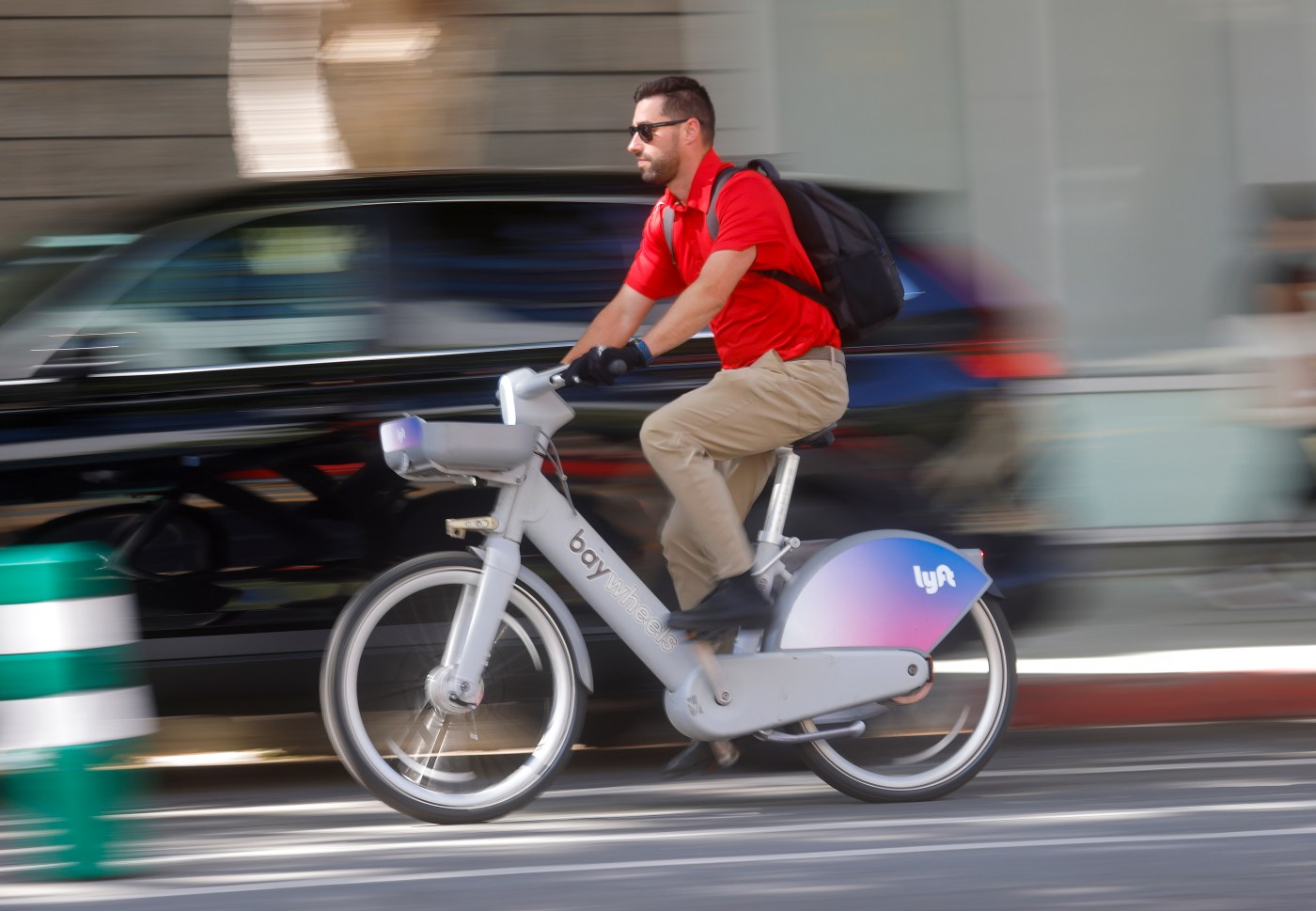Late last month, Pax Jolie-Pitt, the 20-year-old son of movie stars Angelina Jolie and Brad Pitt, landed in the intensive care unit with head trauma and a hip injury after he rammed his e-bike into the rear of a parked car idling at a red light in Southern California.
The crash grabbed headlines across the globe, but it is far from an isolated incident. A recent UCSF study found that e-bicycle injuries doubled nationally every year from 2017 to 2022. E-scooter injuries rose by 45%. The study showed that more than 23,000 e-bike riders were injured in 2022. More than 56,000 injuries were logged from e-scooter accidents that same year.
“I’m very pro e-bike and micro-mobility is here to stay. … But they go at high speeds and can be dangerous,” said Dr. Benjamin Breyer, the study’s senior author and chair of the UCSF Department of Urology.
Jolie-Pitt was not wearing a helmet. He has been released from the hospital, but reportedly faces a long road to recovery.
Injuries are up, in part, because the bikes are increasingly popular. More than 1 million electric bikes were sold in the United States last year, and that number is expected to double this year. E-bikes have led to reduced oil consumption and less pollution, inspired couch potatoes to get outdoors and exercise and given commuters an inexpensive and eco-friendly way to get to the office. But they’ve also sparked safety concerns and tension between those who favor restricting where they’re allowed and those who worry new rules could stifle growing interest in a healthy activity.
The low-emission bicycles can travel up to 28 miles an hour, are convenient, relatively affordable, reduce congestion and allow riders to cover more distance with less effort.
The average price is between $600 and $2,500, and there are plenty of models to choose from, including mountain e-bikes and electric trikes.
Proponents point out that e-bikes are great for commuting, because they are much cheaper than a car and can also help people get to jobs that are hard to reach by public transportation. They can also carry much larger loads than traditional bikes, because the rider does not have to expend as much energy peddling. E-bikes can make cycling more accessible to a wider range of people, including those who may have difficulty riding a traditional bike.
But some riders of the popular bikes have drawn criticism, particularly as e-bikes have become more prolific, with some Bay Area cities and counties cracking down recently on lawless behavior that often leads to injuries, collisions and property damage or destruction.
Palo Alto last year banned e-bikes from unpaved trails in the Baylands Nature Preserve after people raised concerns that the fast-moving, heavy e-bikes could negatively impact wildlife and other trail-goers’ peaceful ventures in nature.
Earlier this summer, the Danville Town Council voted unanimously to ban e-bicycles on sidewalks in the business district after the police department reported an increasing number of complaints about scooters and e-bikes on sidewalks.
A bicyclist rides an electric bike across Hartz Avenue on Monday, July 8, 2024, in Danville, Calif. The town of Danville is considering measures to ban electric bikes from downtown area sidewalks. (Aric Crabb/Bay Area News Group)
And on Tuesday, the Santa Cruz County Board of Supervisors is expected to give final approval to a similar ordinance that expands existing county code to specify that electric bicycles as well as certain motorized vehicles such as mopeds may not be driven on sidewalks in unincorporated areas of the county.
As a surge in young people take to e-bikes, schools from K-12 to college are attempting to get a handle on the bikes, too.
San Jose State University barred electric devices of all kinds from its downtown campus five years ago and the Larkspur-Corte Madera School District in Marin County is requiring students to register e-bikes starting this fall.
While cities and police departments report that teens and young people are the ones engaging in dangerous and unlawful behavior, the UCSF study found that the median age for injured e-bicyclists was actually 39, compared with 30 for injured conventional bikers. The median age for injured e-scooter riders was 30 years old compared with 11 for conventional scooter riders.
Larry Tetone, manager at Alameda Bicycle, said he wasn’t surprised that injuries were rising among older riders, simply because of the surge in popularity with all age groups. Tetone uses his e-cargo bike to haul his kids around and said all the fuss about packs of kids riding in the road might be overblown.
People ride electric bikes on the Iron Horse Trail in Danville, Calif., on Thursday, Aug. 15, 2024. (Shae Hammond/Bay Area News Group)
“I don’t think there is anything inherently wrong with kids riding in the road. I think that can be a positive thing,” he said. ” It’s different if they are shutting down a freeway or a major thoroughfare.”
State law requires bike riders under 18 to wear a helmet and bans anyone under 16 from riding a Class III e-bike, one that can travel up to 28 mph, but adults are not required to ride even e-bikes with a helmet.
“This increase in accidents not only introduced a demographic shift, but also underscores an urgent need for added safety measures,” said co-lead study author Dr. Adrian Fernandez, a chief resident with the UCSF Department of Urology.” There are undeniable health and environmental benefits to micro-mobility vehicle use, but structural changes must be taken to promote safe riding.”
Related Articles
Bicyclist survives 100-foot fall down Big Sur landslide, helicoptered to hospital
Bicyclist, 60, dies in San Jose’s 26th traffic fatality of year
Santa Cruz’s Haley Batten makes history for Team USA
Bikes & bites: Three iconic Bay Area bike trails and where to eat along the way
Walnut Creek: Flow trail project abandoned at Lime Ridge Open Space
Nonprofit organization Bike East Bay spokeswoman Chelsey Prewitt said the group has seen an uptick in people asking about e-bikes, how they work and what measures to take to be safe on the streets. The group offers classes on how to ride in traffic, the importance of wearing a helmet, how to lock up a bike and how to best ride at night and in wet weather.
“We want all people to be safe on streets and get them to where they need to go, and most of the time people just need the education on how to best move safely,’’ Prewitt said. “Our goal at Bike East Bay is to make that knowledge accessible and have a low barrier of entry to our classes.”
As injuries have surged, a spate of bills have cropped up at the state level, including a bill that would require all electric bikes sold in California to meet certain minimum safety standards and be certified by an accredited testing laboratory. Another bill proposed statewide e-bike licensing.
But not everyone believes the restrictions are the appropriate response.
“We think this backlash against e-bikes is the wrong direction for what we want for safer ways for people biking and sharing the road,” said Jared Sanchez, the policy director for the California Bicycle Coalition. “We don’t believe that adding restrictions for people riding e-bikes is the solution.”
A rider uses an electric bicycle heading east along East San Fernando Street in downtown San Jose, Calif., on Wednesday, August 7, 2024. (Nhat V. Meyer/Bay Area News Group)
Reporters Cameron Duran and Caelyn Pender contributed to this story.












